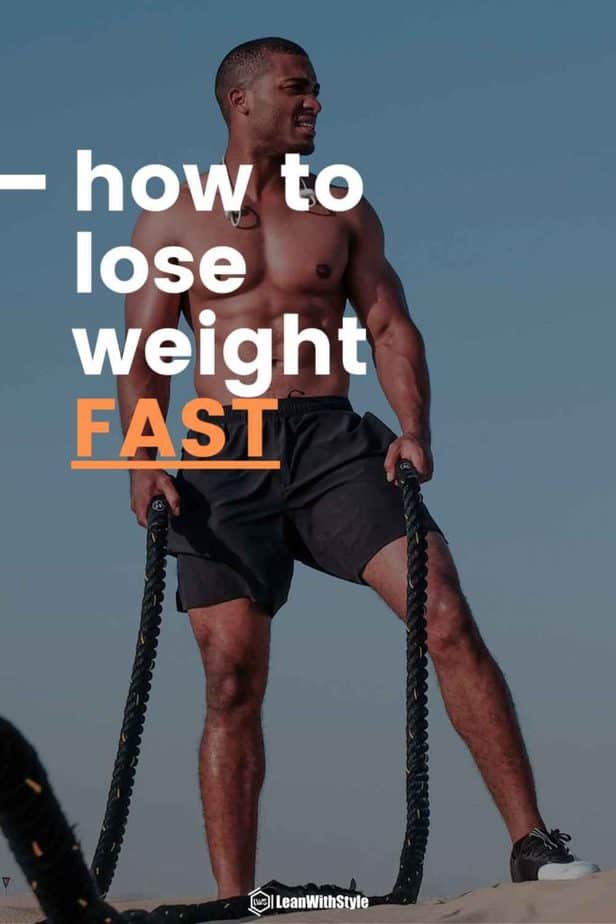If you want to learn how to lose weight fast, without getting the negative effects of “crash dieting,” then you want to read this article.
This aggressive approach works if:
- You have a ton of fat to lose
- You need to get in shape quickly for an event (Wedding, Birthday, Summer, etc.).
- You’re just over it and want to get in great shape

How NOT To Lose Weight

Here’s what NOT to do when trying to lose weight:
- Do tons of cardio.
- Starve yourself and eliminate foods that you like.
- Don’t eat enough protein.
- Don’t lift heavy weights.
- Lift light weights to see the “cuts.”
If you want to look weak, skinny, saggy, or just look like you have no definition at all, then you would stop reading here and just reduce your calories.
However, I believe that is the exact OPPOSITE of what you want.
The goal of this article is to help you lose weight quickly and safely.
The goal is also to show you how to KEEP it off which is way more important in the grand scheme of things.
Losing weight by crash dieting will only result in you gaining the weight back. Don’t do a crash diet (do the opposite), juice cleanse, or anything like that. It’s not necessary.
The Best Way To Lose Weight (7 Steps)
To begin to lose weight fast, you want to have a plan.
This plan can work whether you have 30 pounds to lose or 300 pounds.
The very first thing you must understand is this:
You will not lose weight if you’re NOT in a caloric deficit. [1]
To lose weight, you must burn more calories than you consume.
There’s no getting around it.
I don’t care if you’re following paleo, keto, a high carb diet, or just eating broccoli for breakfast, lunch, and dinner.
If you’re not in a caloric deficit, you will not lose weight and definitely not fat.
This article will not go into every detail about weight loss and fat loss, however, it will show you what to do, step-by-step.
So here’s the first thing you need to do.
Step 1: Set Your Calories For Fast Weight Loss
To lose weight fast, you need an aggressive calorie deficit.
To do this, just multiply your GOAL body weight (in lbs.) by 11.
Ex: If I were 250 pounds and wanted to weigh 200 pounds, I would multiply my goal body weight, 200, by 11.
200 x 11 = 2200 Calories
Note: This is an aggressive fat loss plan. If you want something that isn’t as aggressive, check out this IIFYM guide.
Step 2: Track Calories and Protein Only

When it comes to dieting down fast, tracking your calories and being in a calorie deficit is the most important thing.
However, what’s just as important is keeping track of your protein intake.
With this aggressive approach, you can forget about tracking carbs and fat (for now).
So long as you’re in a calorie deficit, you will lean down.
You want to make sure you’re getting 0.7-0.9g of protein per lb of body weight.
I’m personally not a fan of eating a crazy amount of protein.
If you do like more protein and want to eat more, you can increase this to 1 gram per lb or even 1.2 grams per lb.
Whatever you chose, know that your protein intake is crucial. [2] [3]
You don’t want to burn through muscle while dieting.
If you lose weight through a calorie deficit, you’ll end up looking “skinny fat” like Russel Brand in Forgetting Sarah Marshall:

Step 3: Eat 2-3 Meals a Day by Following Intermittent Fasting

Intermittent Fasting is the key here to losing weight fast.
Studies show it’s numerous health benefits and I’ve written articles on the benefits and intermittent fasting for women.
This dieting strategy makes losing weight and eating less food a whole lot easier.
Here’s how to do it:
- Push your first meal back 4-6 hours upon waking.
- Use coffee and/or sparkling water to suppress appetite during this 4-6 hour period.
- Eat a big meal at lunch (5-8 hours after waking)
- Eat a lighter meal at dinner/night time.
- Have one serving of fruit (preferably an apple) before your big meal and one serving of fruit before your lighter meal.
A sample day would look something like this:
- wake up – 7 am (drink water for first couple of hours)
- coffee – 9 am (enjoy 2-3 cups of coffee over a couple of hours)
- snack to push big meal back (1 apple) – 12pm
- Big lunch – 1 or 2 pm
- Snack (1 apple) – 6 pm
- Medium Dinner – 8 pm
Your “Big Lunch” should roughly be 800-1400 calories depending on what your specific calories are.
The “Medium Dinner” would be the remaining calories (minus the two apples which are usually 100-200 calories) or use those calories for your meals.
The apples are useful for suppressing hunger, but it’s not necessary.
This simple, yet effective, ‘2 meals per day’ meal plan is not something I figured out on my own.
It’s what I picked up from men in the fitness industry like Rusty Moore and Radu Antoniu.
It’s only one example of many. There are many different ways you could follow intermittent fasting.
Recommended Reading:
Intermittent Fasting Benefits – Crazy Useful for Fat Loss
Step 4: Strength Train 3-4 Days Per Week

For 3 or 4 days out of the week, lift weights that challenge you.
No, NOT light weights with high reps.
You want to lift heavy enough to signal to your body that you want to keep the muscle.
Here’s what I mean when I say “heavy”:
- For Women, pick a weight that you could do for 8 reps but NO more than 10 reps.
- For Men, pick a weight that you could do for 4 reps but NO more than 6 reps.
For example, for women, if you could get 10 reps, but to get the 11th rep, you would have to give it “everything” you got, then it’s probably the right weight.
You’ll have to play around with it for a bit.
For your workout routine on these 3-4 days, what you want to do is focus on hitting compound movements at the beginning of the workout:
- bench press,
- squats,
- deadlifts,
- overhead press)
and end with isolation movements:
- bicep curls,
- tricep pulldowns,
- lateral raises,
- leg extensions,
- etc.
If you want a sample plan, use this FREE Beginner Workout Routine to start.
Step 5: HIIT Cardio 3 Times a Week + 1 LISS a Week

3 times a week, I want you to perform High-Intensity Interval Training, otherwise known as HIIT.
Performing HIIT will give you the biggest bang for your buck in terms of calories burned and overall health improvement.
An example of HIIT on the treadmill would look like this:
- Sprinting as fast as you can for 15-20 seconds (This will depend on how fast your treadmill can go. For example, my gym’s treadmill has a top speed of 12 and I usually sprint at level 9, 10, or 11).
- Walking at 3 mph for 1-2 minutes
- Repeat for 15-20 minutes
- You can do this outside as well. Just run as hard as you can for 15-20 seconds and walk for 1-2 minutes.
Recommended Reading:
The Ultimate Guide On HIIT For Weight Loss
LISS – Low intensity interval training
Low-Intensity Steady State (LISS) is also effective at burning calories, but it just takes longer to complete.
I suggest doing 1 LISS session a week after one of your lifting workouts or on a rest day.
An example of LISS on the treadmill would look like this:
- Set the incline to however high you like. The higher the incline, the more calories you’ll burn.
- Set the speed to something comfortable. I choose speed 2 because I can walk the entire time without holding onto the handles.
- Stay at this speed for 45 minutes.
Adjustments to the Cardio Schedule
If you’re a beginner, HIIT can be a tough task to accomplish.
If you want to, feel free to switch it up and do 2 HIIT workouts a week and 2 LISS workouts per week.
Whatever you can follow is what will work best for you.
Step 6: Incorporate 1 “Refeed” Day Per Week (optional)

Once per week, you want to incorporate something called a “Refeed” Day.
A Refeed Day is where you increase your carbohydrate intake by 400-600 calories or 100-150 grams of carbs for this one day.
I would recommend keeping your big “first” meal (as described above) the same and use these carbs for the “medium” meal.
This way, you have two big meals for the day.
For example, if your big meal is around 1000 calories, and your “medium dinner” is about 500 calories, then you would add 600 calories to your medium dinner, and you would have two big meals for the day!
Why do we do this?
Well, incorporating a “Refeed” helps us not only adhere to the aggressive fat loss plan but also helps “restart” your metabolism in a way.
It tells your body that you’re not starving:
“I’m still alive, don’t worry.”
This is a very simplified description of the Refeed day.
I recommend reading this article to learn more about it if you’re interested.
I say that the Refeed Day is optional because if you’re fine without it and feel like you don’t need it a certain week, then skip it and keep the weight loss train rollin!
Step 7: Adjust Based On Your Results
As you follow this plan, you may run into plateaus every so often.
I recommend weighing yourself and taking waist measurements every day and taking the weekly average.
If the weekly average isn’t going down each week, then you need to adjust your calories, or be more active or both.
Recommended Reading:
How to Track Your Weight Loss Progress – Simple Guide
Review of Your Fast Weight loss Plan
This simple guide should help you lose fat at an aggressive pace.
You should lose 1.5-3 lbs per week using the calorie multiplier mentioned above.
Remember, a calorie deficit is what produces weight loss.
If you want to lose weight AND fat, then you want to:
- Get enough protein (0.7-1.2g per pound of body weight)
- Strength train 3-4 days per week
- Do HIIT and LISS
- Utilize intermittent fasting to make eating in a caloric deficit EASY
Doing these things and the other topics mentioned in this article and you will lose fat.
Conclusion (An All-In-One Approach)
I understand that some of you are desperate to start off your fat loss journey on the right foot and start off fast.
I get it.
I was in the exact same position.
It’s why I made this post.
However, the strategy that is laid out above… I didn’t come up with it myself.
There are little bits and pieces from 4-5 products I’ve taken and read thoroughly from people who’re much smarter than me.
The majority of this strategy comes from Greg O’ Gallagher’s program called Aggressive Fat Loss.
Greg taught me a whole lot about fat loss when I was first getting started a few years back.
If you want to fast track your success I recommend getting straight to it and buying his program.
I’ve gone through it 4-5 times now and I assure you it’s worth the price.
If you’re interested, click the button below now:
Chris





Question: I didn’t understand if the calories you get from multiplying by 11 was how much you can consume in a day or how much to burn in a day.
It’s how much you can consume in a day!
“Get enough protein (0.7-1.2g per pound of body weight) ” is this the protein intake per day, week, or month?
and what should be the maximum carb, fat, and fiber intake per day/week/month/
It’s per day! Sorry for the confusion. There is no maximum for carbs/fats as long as you get enough protein and are in a calorie deficit 😀
When using words like “HllT” you should explain. Or spell out the words in order for people to understand, what message you are conveying.